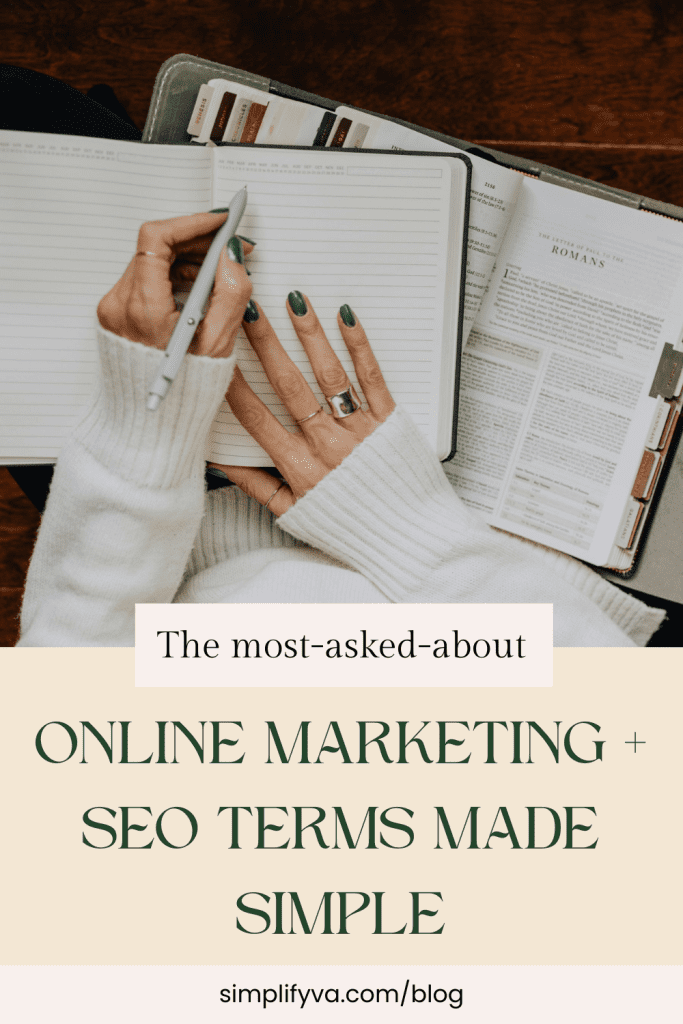Online Marketing + SEO Terms Made Simple: Your Essential Glossary

If the world of digital marketing and SEO terms sounds like a foreign language to you, you’re not alone!
When you’re running a business, the last thing you need is to spend hours decoding marketing jargon. That’s why I’ve created this glossary to help you understand the essential terms—simply and without the confusion.
Let’s break it down.
Essential Online Marketing + SEO Terms You Want to Know
Alt Text
A text description added to images to improve accessibility and help search engines understand visual content.
Anchor Text
Clickable text (usually underlined or in a different color) that links to another page. Example: Check out our SEO services (where SEO services is the anchor text).
Bounce Rate
The percentage of visitors who leave a website after viewing only one page. A high bounce rate may indicate that the page isn’t engaging or relevant.couraging users to take action, such as Sign up for free, Get started today, or Download your guide.
Call to Action (CTA)
A prompt encouraging users to take action, such as Sign up for free, Get started today, or Download your guide.
Click-Through Rate (CTR)
The percentage of people who see your content and actually click on it. A high CTR means your content is engaging and relevant!
Crawlers (Search Engine Bots)
Automated programs (like Google’s crawlers) that scan and index website content, helping determine how your site ranks in search results.
Domain Authority (DA)
A score that predicts how well a website will rank on search engines, based on factors like backlinks and overall credibility.
Evergreen Content
Content that remains relevant over time, continuing to attract traffic long after it’s published (many blog posts, podcasts and YouTube videos are evergreen since people will continue to find them over time).
H1, H2, H3 (Headers)
Headings in your content that structure your page and signal importance to search engines. H1 is your main title, H2s are subheadings, and H3s further break down sections.
Hyperlink
A clickable link that takes users to another webpage. Can be internal (within your site) or external (to another website).
Interlinking
Using internal links to connect different pages on your website, improving SEO and user experience.
Key Performance Indicators (KPIs)
Metrics that track success, such as conversion rates, cost per lead, or organic traffic growth.
Keyword (KW)
The search terms people type into Google. Using the right keywords in your content helps your site rank higher.
Long-Tail Keywords
More specific keyword phrases that attract highly targeted traffic, like best SEO tips for service-based businesses.
Meta Description
A short summary (155-160 characters) of a webpage that appears on search engine results pages (SERPs), helping users decide whether to click.
Meta Title
The clickable blue title on a Google search results page. Keep it under 60 characters for best results!
NoFollow Link
A hyperlink with a tag that tells search engines not to pass SEO value to the linked page. Often used for paid links or untrusted sites.
On-Page SEO
An SEO term referring to the optimization of individual web pages with strong copy, meta tags, keyword-rich headers, and mobile-friendly design.
Off-Page SEO
SEO strategies outside your website, like link building and social media marketing, that drive traffic and boost authority.
Pay-Per-Click (PPC)
A paid advertising model where you pay each time someone clicks on your ad—like Google Ads.
Search Engine Marketing (SEM)
A broader strategy that includes both organic (SEO) and paid (PPC) tactics to increase website visibility.
Search Engine Optimization (SEO)
The process of improving your website’s rankings on Google organically (without paid ads). SEO includes keyword optimization, content creation, and technical improvements.
Search Engine Results Page (SERP)
The list of results displayed when you search on Google.
Standard Operating Procedure (SOP)
A step-by-step guide that documents business tasks for consistency and efficiency.
Scope of Work (SOW)
A detailed agreement outlining what’s included in a project, helping set clear expectations.
Search Volume (SV)
The number of times a keyword is searched per month, helping you choose the best keywords for your content strategy.
Unique Selling Proposition (USP)
What makes your brand different from the competition? It could be your personalized service, a unique offer, or your brand voice!
User Experience (UX)
The overall experience a visitor has on a website, including ease of navigation, speed, and accessibility.
Still Have Questions?
Marketing doesn’t have to feel overwhelming. If there are other online marketing or SEO terms that you’re confused about, drop me a comment and I’ll be happy to add it to the list.
To your marketing success!
